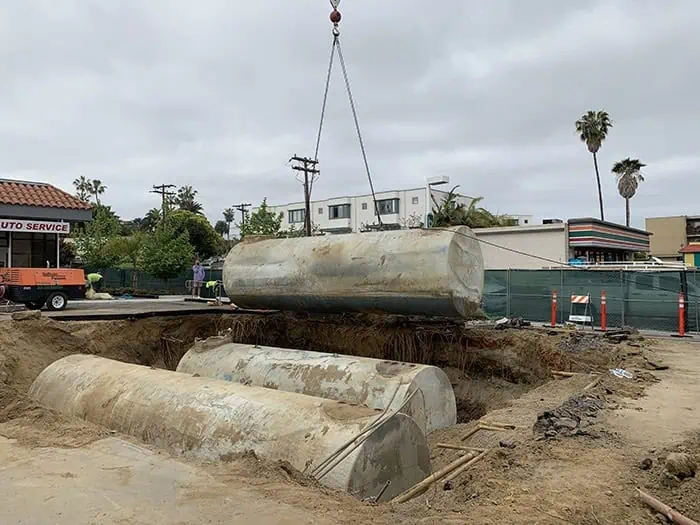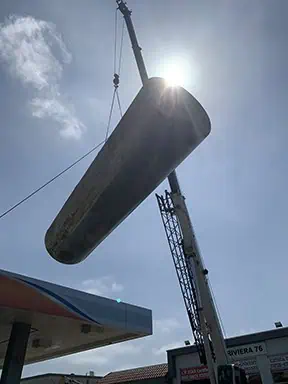

The Association for Environmental Health and Soils (AEHS) is hosting the 40th Annual International (East Coast) Conference on Soils, Sediments, Water, and Energy in Amherst, Massachusetts from October 21 to 24, 2024. This AEHS conference integrates a variety of topics for the environmental science community and regulators. It offers an opportunity to stay updated on recent techniques and technologies for addressing environmental issues and solutions. SCS Engineers technical advisors and environmental professionals are attending the 2024 AEHS conference and are available to answer and discuss solutions for the covered topics.
PFAS
Per- and polyfluoroalkyl substances, called PFAS, is a major topic covered during the sessions. Three workshops and several presentation sessions are addressing various aspects of PFAS challenges. Sessions will cover an overview of methods and materials for field sampling activities and published sampling protocols, guidance, and procedures. They will also address various analytical methods for evaluating PFAS in drinking water, wastewater, solids, and biosolids, as well as the best practices for field collection and the available analytical methods and their applicability.
PFAS Treatment
Another significant topic will be PFAS treatment and remediation. One session covers an innovative approach combining foam fractionation with supercritical water oxidation to eliminate PFAS from various waste streams. Destructive technologies, including electrical discharge plasma treatment, thermal destruction, enhanced oxidation, and sonolysis, have shifted from the laboratory bench to the field. Therefore, one of the presentations will cover the various mechanisms used to destroy PFAS, compare early performance data to determine effectiveness and highlight successes and obstacles that may occur as these technologies move from pilot scale to full-scale implementation.
Metals Remediation and VOCs
Other topics include metals remediation, such as an in-situ chemical fixation process that co-precipitates arsenic via the formation of an iron-arsenic oxyhydroxide complex, and the remediation of lithium, molybdenum, boron, and arsenic at coal combustion residual sites. The investigation and remediation of chlorinated volatile organic compounds (cVOCs) will also be discussed in various sessions, covering the use of real-time 3-dimensional data visualization and analysis during a high-resolution site characterization, investigation using the membrane interface hydraulic profiling tool for the delineation of cVOCs and remediation using emulsified zero-valent iron for direct source mass destruction.
Regulations and Adapting Technologies for Emerging Contaminants
Other topics include bioremediation, vapor intrusion, statistics, sustainable remediation tools, climate change and resiliency, managing environmental data, in-situ remediation, and environmental security. The event dedicates one session to emerging environmental contaminants in drinking water, such as microplastics, nanomaterials, and PFAS. This session will also discuss the current status of United States regulations and provide a forecast of the potential trajectory of regulations and the corresponding legal landscape over the next one to two years.
AEHS also organizes a similar West Coast conference. The West Coast 34th Annual International Conference on Soil, Water, Energy, and Air Conference will be held March 17-20, 2025, in San Diego, California.
Additional Resources:
Statistics is the science of learning from data and using the results in many industries for various purposes. As environmental consultants, we use statistics primarily to help clients meet regulatory requirements because statistical analyses can provide valuable insights and guidance, potentially saving our clients’ money and time.
Various statistical methods can help streamline assessment and remediation concerning contaminated site cleanup, ultimately facilitating site closure. Statistical analysis can help to answer some important questions that arise throughout the life cycle of a project. The table below summarizes some common statistical questions, statistical methods, and data visualizations (statistical questions modified from ITRC, 2013*).
Statistics is one tool for solving client problems in combination with other methods. However, it is important to note that the output of a statistical analysis is only as good as the input, meaning that the collection of quality field samples and adherence to relevant standard operating procedures are crucial to the quality of statistical analysis.
In conclusion, while statistical analysis is a powerful tool for addressing client environmental issues, its effectiveness depends heavily on the accuracy of data collection and strict adherence to established protocols, ensuring reliable and meaningful results for our clients.
SCS has successfully implemented each of these methods on project sites. Future blogs will describe specific methodologies and processes with actual case studies useful for addressing the following,
Background Studies: after calculating the appropriate background level or establishing a background data set, that level or data set could support the removal of a particular contaminant from further consideration or serve as the remediation objective.
Groundwater trend analysis: to evaluate whether groundwater concentrations are increasing, decreasing, or stable/no trend, which could support the completion of long-term groundwater monitoring. This approach can also help estimate the time to attain cleanup goals.
Spatial Statistics: use several methods to evaluate spatial hot spots and outliers, groundwater plume stability, and groundwater concentration or elevation gradients, which can aid in evaluating areas of high concentrations requiring further evaluation.
*Interstate Technology & Regulatory Council (ITRC) Framework for Developing Quality ITRC Technical and Regulatory Guidance Documents, Revised December 2013
Additional Site Assessment and Remediation Resources:

Reach Out Toll-Free +1 (800) 767-4727
Our receptionists answer calls between 8:30 am ET through 5:00 pm PT. We promptly answer voicemails and messages sent to our general email () 24/7.
Client Feedback Tool
SCS solicits feedback from clients during ongoing projects via short (2-3 minute) surveys using our electronic Client Feedback Tool (CFT). These surveys are designed to ensure we are on track to deliver project solutions to your satisfaction. Surveys are less than ten questions, and space is available for additional comments. Your Project Manager will work to establish a convenient schedule for you if you’d like to participate. This is not a marketing survey. It is a way to check in with you regularly to ensure your project is on track, in addition to regular communications with your Project Manager. Your participation is greatly appreciated.
Quality Management
SCS maintains a stringent, comprehensive Quality Management program. Quality Management ensures that SCS staff professionals, scientists, technologists, and field technicians, including administrators and subcontractors, have the necessary training, tools, and skills to employ sound, ethical processes on every environmental solution.
Our robust program includes apps built by SCS for our staff to continuously improve our services and communications. SCS staff have access to thousands of resources at the touch of a button, including libraries, compliance documents, safety information, training, and our National Experts and specialists nationwide to maintain the highest level of quality in our products and services. We make many of our resources available on our website, too.
The Website
SCS’s website is a rich resource for our clients and visitors. The site has two primary filters: one to find local staff with specific environmental experience. The second is a search filter that results after a search to help you target our resources, available on demand. Service descriptions, articles, whitepapers, blogs, events, and videos can be resources. Each page enables you to print or share the resource privately with others or on social media.
Free Environmental Educational Videos
The SCS Engineers Learning Center contains recorded open forums where participants ask questions throughout. The video recordings are available in our Learning Center to watch at your convenience. These are educational videos, not sales pitches, as we share our experience and expertise in environmental fields with individuals and businesses to enhance a clearer understanding of modern environmental solutions and technologies available.
On September 16th, the U.S. Environmental Protection Agency (EPA) announced $117 million for three separate funding opportunities to advance recycling infrastructure and boost food waste prevention education across the country. Two of the notices are for Solid Waste Infrastructure for Recycling grants – one funding opportunity for Tribes and intertribal consortia and another for communities (such as cities, counties, and parishes) across the country. The third notice is for EPA’s Recycling Education and Outreach grant program and is focused on food waste prevention and composting. All three opportunities provide the largest EPA investment in recycling in more than 30 years.
Communities in Need
Some communities that lack waste management infrastructure do not have curbside waste collection services, recycling, or composting programs, which increases the strain on local waste management systems and increases greenhouse gas emissions. In addition, mismanaged waste contributes to health and economic issues in historically underserved and overburdened communities. Increasing recycling reduces climate, environmental, and social impacts of materials use and keeps valuable resources in use instead of in landfills. Preventing wasted food from ending up in landfills plays an important role in reducing greenhouse gas emissions.
Working Toward a National Strategy
The grant opportunities aim to improve waste management systems and consumer education and outreach on waste prevention and recycling, meeting U.S. goals to create a stronger, more resilient, and cost-effective U.S. recycling system. These funding opportunities also put the concrete steps identified in the “National Strategy for Reducing Food Loss and Waste and Recycling Organics” into action.
Recycling Education and Outreach Grant Funding Programs aim to increase recycling through composting, less wasted food from households, markets for selling compost, and lower contamination in the compost stream. Projects funded through the Solid Waste Infrastructure for Recycling and Recycling Education and Outreach grants will improve post-consumer materials management and infrastructure using the basis of sustainability and a circular economy.
Additional Resources:

The California State Water Resource Control Board ordered the closure of single-walled underground storage tank systems and single-walled product piping at all facilities. The deadline to remove all single-walled underground storage tanks and single-walled piping is December 31, 2025.

Underground storage tanks recognized as out of compliance will be subject to enforcement actions beginning January 1, 2026.
Grants and loans may be available to eligible small business owners who want to remove, replace, or upgrade USTs.
The professionals at SCS Engineers are ready to assist with closing and removing underground storage tanks. SCS Engineers provides turnkey services, including licensed tank removal contractors, consulting services for agency compliance, and California-certified analytical testing laboratories.
SCS’s National UST Practice Covers:
Contact a UST professional at SCS Engineers today at ; for service in California, click here.
For information on the EPA Federal program, click here.
Additional California Code Information:
Health and Safety Code – HSC
DIVISION 20. MISCELLANEOUS HEALTH AND SAFETY PROVISIONS [24000 – 26275] ( Division 20 enacted by Stats. 1939, Ch. 60. )
CHAPTER 6.7. Underground Storage of Hazardous Substances [25280 – 25299.8] ( Chapter 6.7 added by Stats. 1983, Ch. 1046, Sec. 3. )
25292.05.
(a) On or before December 31, 2025, the owner or operator of an underground storage tank shall permanently close that underground storage tank in accordance with Section 25298 and the regulations adopted pursuant to that section, if the underground storage tank meets either of the following conditions:
(1) The underground storage tank is designed and constructed in accordance with paragraph (7) of subdivision (a) of Section 25291 and does not meet the requirements of paragraphs (1) to (6), inclusive, of subdivision (a) of Section 25291.
(2) The underground storage tank was installed on or before January 1, 1984, and does not meet the requirements of paragraphs (1) to (6), inclusive, of subdivision (a) of Section 25291.
(b) Notwithstanding subdivision (a), the board may adopt regulations to require the owner or operator of an underground storage tank to permanently close that underground storage tank before December 31, 2025, in accordance with Section 25298 and the regulations adopted pursuant to that section, if the underground storage tank meets the conditions specified in either paragraph (1) or (2) of subdivision (a) and the underground storage tank poses a high threat to water quality or public health. The board shall consult with stakeholders before adopting regulations pursuant to this subdivision.
(Added by Stats. 2014, Ch. 547, Sec. 1. (SB 445) Effective September 25, 2014.)
The commercial office sector in cities around the country is facing unprecedented challenges due to high vacancy rates that have been driven by factors including the work-from-home trend and the highest interest rates in almost 20 years. SCS Engineers worked with a panel of experts in the fields of economics, law, architecture, property development, and building sciences to explore the opportunities and challenges of the adaptive reuse of existing commercial buildings into new uses such as residential ones.
The resulting article provides valuable solutions and insight and can be found in Western Real Estate Business at this link: Western Real Estate Business April 2024 Page 20
SCS Engineers provides environmental consulting services for the real estate industry, including asbestos and lead-based paint surveys that are often needed before any building renovations or adaptive reuse. Once asbestos-containing materials or lead-based paint is identified at the building site, abatement activities to remove or mitigate the risks from these materials take place.
SCS monitors these abatement activities with air monitoring and inspections to make sure the removal is conducted according to regulations, and to protect workers and members of the surrounding community from exposure to these harmful chemicals; protecting and rehabilitating these spaces for re-occupancy.

Additional Information:

Jenny’s passion for mentoring staff and building client relationships makes her a valuable asset to our team.
Outside work, she enjoys camping in southern Missouri and exploring the Ozark trails on ATVs with her family.
Congratulations, Jenny!

Not only is Morgan a skilled project manager, but he also excels as a mentor, guiding young engineers in the principles of civil engineering design. His diverse talents have made a significant impact on SCS, particularly in the Energy and Construction sectors.
Originally from a ranch in southern Colorado, Morgan’s journey led him to the Colorado School of Mines and eventually to his role as a City Engineer, where he met his wife Tess, a journalist covering City activities. Together, they are proud parents to three children and are currently immersed in planning their eldest’s wedding, attending swim meets, and cheering loudly at soccer games.
Please join us in congratulating Morgan on this well-deserved promotion. We look forward to witnessing his continued success and contributions to our organization.
Please contact SCS Engineers if you are interested in working with our clients to make the world safer and cleaner!

Internally, Tim is known for his humility and collaborative nature, always willing to share his knowledge and mentor colleagues with his client-first approach. In recognition of his outstanding contributions, Tim has been promoted to Project Advisor, where he will continue to deliver exceptional service to clients at a high technical level.
Outside of work, Tim celebrates important milestones in his personal life, including 20 years of marriage to his wife Heidi and raising two sons. In his free time, Tim enjoys quality time with his family and sharing his passion for music by playing trumpet and euphonium alongside his sons at local churches.

Bret is passionate about developing our staff in Overland Park and ensuring their professional growth. His business acumen and analytical skills are vital in addressing business challenges and driving continued success.
Congratulations, Bret, on your well-deserved promotion!

A native of north-central Iowa and a graduate of Iowa State University, Kevin brings a wealth of experience from his time at John Deere and ADM before transitioning to consulting in 2016. Outside of work, Kevin enjoys relaxing on his deck, listening to music with his fiancée, and tending to their lively menagerie of two dogs, ducks, and chickens.
Please join us in congratulating Kevin on his well-deserved promotion. We are excited to see where his leadership takes us in the future!
Please contact SCS Engineers if you are interested in working with our clients to make the world safer and cleaner!
SCS Engineers is working to complete a regional assessment of rare earth elements and other critical mineral (CM) opportunities within parts of Iowa, Kansas, Missouri, Nebraska, Oklahoma, and the Osage Nation as part of a multi-state effort led by the Kansas Geological Survey (Critical Minerals in Coaly Strata of the Cherokee-Forest City Basin | netl.doe.gov).
This project is part of a multi-year Carbon Ore, Rare Earth, and Critical Minerals (CORE-CM, FOA-0002364) initiative funded by the U.S. Department of Energy to address all aspects of establishing a domestic critical mineral supply chain and the reuse of high-value, nonfuel, carbon-based resources. SCS Engineers is working with stakeholders within the Cherokee-Forest City Basin to develop assessments and strategies for waste stream reuse, infrastructural capacities and capabilities, technology development, outreach, and public-private partnerships.
The work from this project will identify information, technology, and infrastructure gaps that will need to be addressed to develop economic opportunities for critical mineral production, refining, and utilization specific to the Cherokee-Forest City Basin. These assessments may be utilized in future Phase II and Phase III components of the planned CORE-CM program for potential implementation within the region.
This study along with others have the potential to reduce U.S. reliance on foreign sources of critical minerals that are essential for electronics, renewable energy technologies, advanced manufacturing, and defense applications. It could also provide coal mines with additional markets for their product, transforming coal from something that is burned into a 21st century feedstock for advanced manufacturing.
Department of Energy Program Goals and Funding
Some research efforts are focused on unconventional and secondary feedstocks, such as coal and coal refuse, coal fly ash, acid mine drainage, mine waste, oil- and gas-produced waters, and brines extracted as part of carbon sequestration efforts. These feedstocks are known to contain elevated concentrations of CMMs, potentially in economic quantities, however their occurrence and distribution is not well constrained.
In April 2024, the U.S. Department of Energy’s (DOE) Office of Fossil Energy and Carbon Management (FECM) announced up to $60 million in funding to create regional teams to support the development of critical mineral and materials supply chains and novel high-value, nonfuel carbon-based products from unconventional and secondary feedstocks, such as coal and coal by-products, effluent waters from oil and natural gas development and production, and acid mine drainage. Realizing the critical mineral and materials potential in these feedstocks would enable the United States to rebuild a domestic supply chain for rare earth elements and other critical minerals and materials—which support high-tech manufacturing and the production of components for clean energy technologies—and reduce our dependence on international supply chains.
The funding period is now closed but projects selected under this funding opportunity will be announced in October and will continue the work of DOE’s CORE-CM Initiative, and expand the focus from the basin scale to a larger, regional scale. CORE-CM projects will develop and implement strategies that enable each specific basin to realize its full economic potential for producing REE, CM and high-value, nonfuel, carbon-based products from basin-contained resources.
Learn More Here:

The U.S. Environmental Protection Agency and the U.S. Department of Energy announced on June 21st that applications are open for $850 million in federal funding for projects that will help monitor, measure, quantify, and reduce methane emissions from the oil and gas sectors. The funding aims to specifically help small oil and natural gas operators reduce methane emissions and transition to available methane emissions reduction technologies, while also supporting partnerships that improve emissions measurement and provide accurate, transparent data to impacted communities.
A competitive solicitation for this funding will enable a broad range of eligible U.S. entities to apply, including industry, academia, non-governmental organizations, Tribes, and state and local governments. This funding opportunity is expected to achieve measurable outcomes for skilled workforce training, community involvement, and environmental justice. Funding applicants are required to submit Community Benefits Plans to demonstrate meaningful engagement with and tangible benefits to the communities in which the proposed projects will be located. These plans must provide details on the applicant’s commitments to community and labor engagement, quality job creation, diversity, equity, inclusion and accessibility, and benefits to disadvantaged communities.
The primary objectives of this funding opportunity announcement are to:
1. Help small operators significantly reduce methane emissions from oil and natural gas operations, using commercially available technology solutions for methane emissions monitoring, measurement, quantification, and mitigation.
2. Accelerate the repair of methane leaks from low-producing wells and the deployment of early-commercial technology solutions to reduce methane emissions from new and existing equipment such as natural gas compressors, gas-fueled engines, associated gas flares, liquids unloading operations, handling of produced water and other equipment leakage.
3. Improve communities’ access to empirical data and participation in monitoring through multiple installations of monitoring and measurement technologies while establishing collaborative relationships between equipment providers and communities.
4. Enhance the detection and measurement of methane emissions from oil and gas operations at regional scale, while ensuring nationwide data consistency through the creation of collaborative partnerships. These partnerships will span the country’s oil and gas-producing regions and draw in oil and natural gas owners and operators, universities, environmental justice organizations, community leaders, unions, technology developers, Tribes, state regulatory agencies, non-governmental research organizations, federally funded research and development centers, and DOE’s National Laboratories.
Additional Resources:
1. Read more details of this funding opportunity.
3.GHG Monitoring, Control, Verification, Reporting